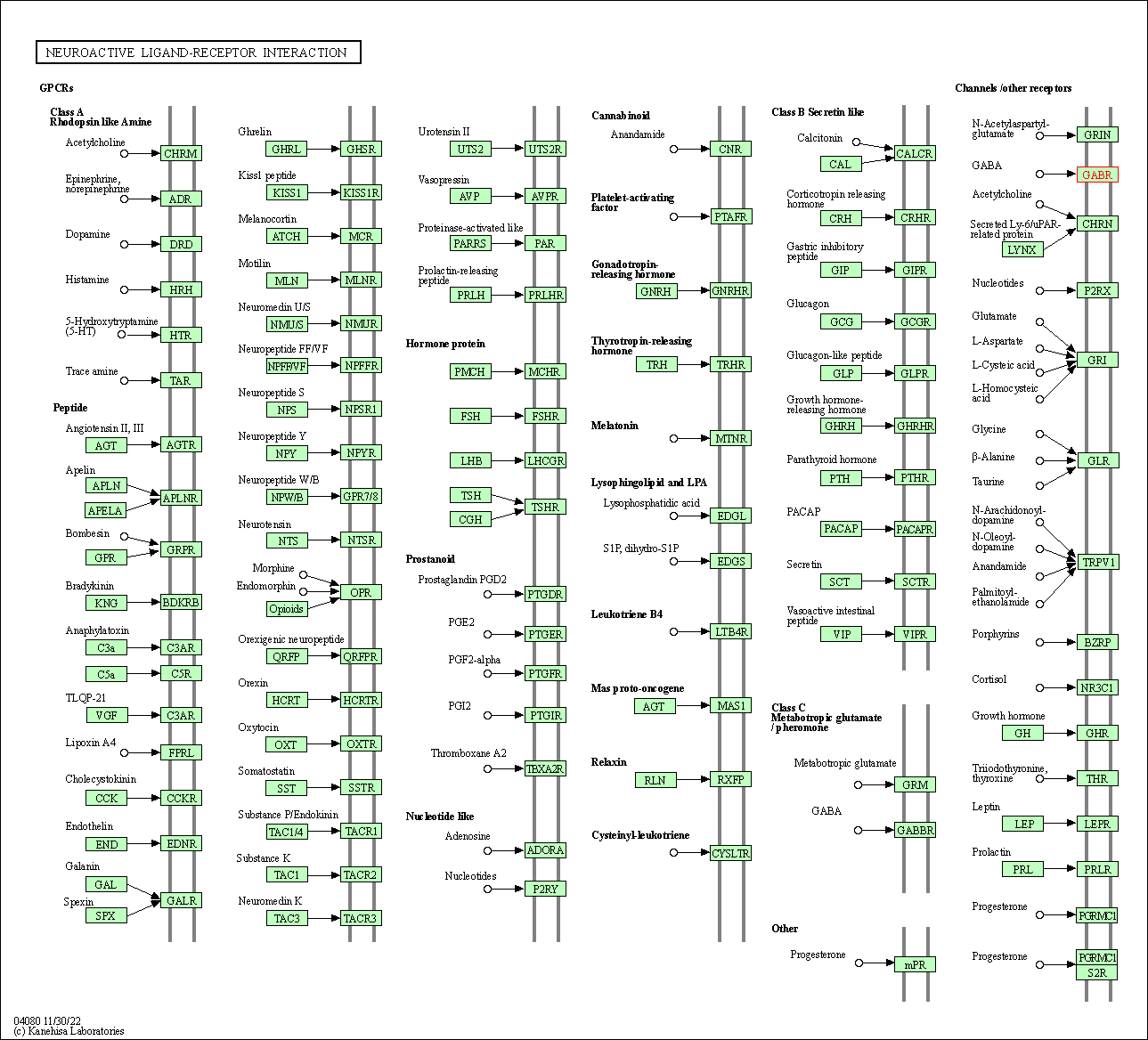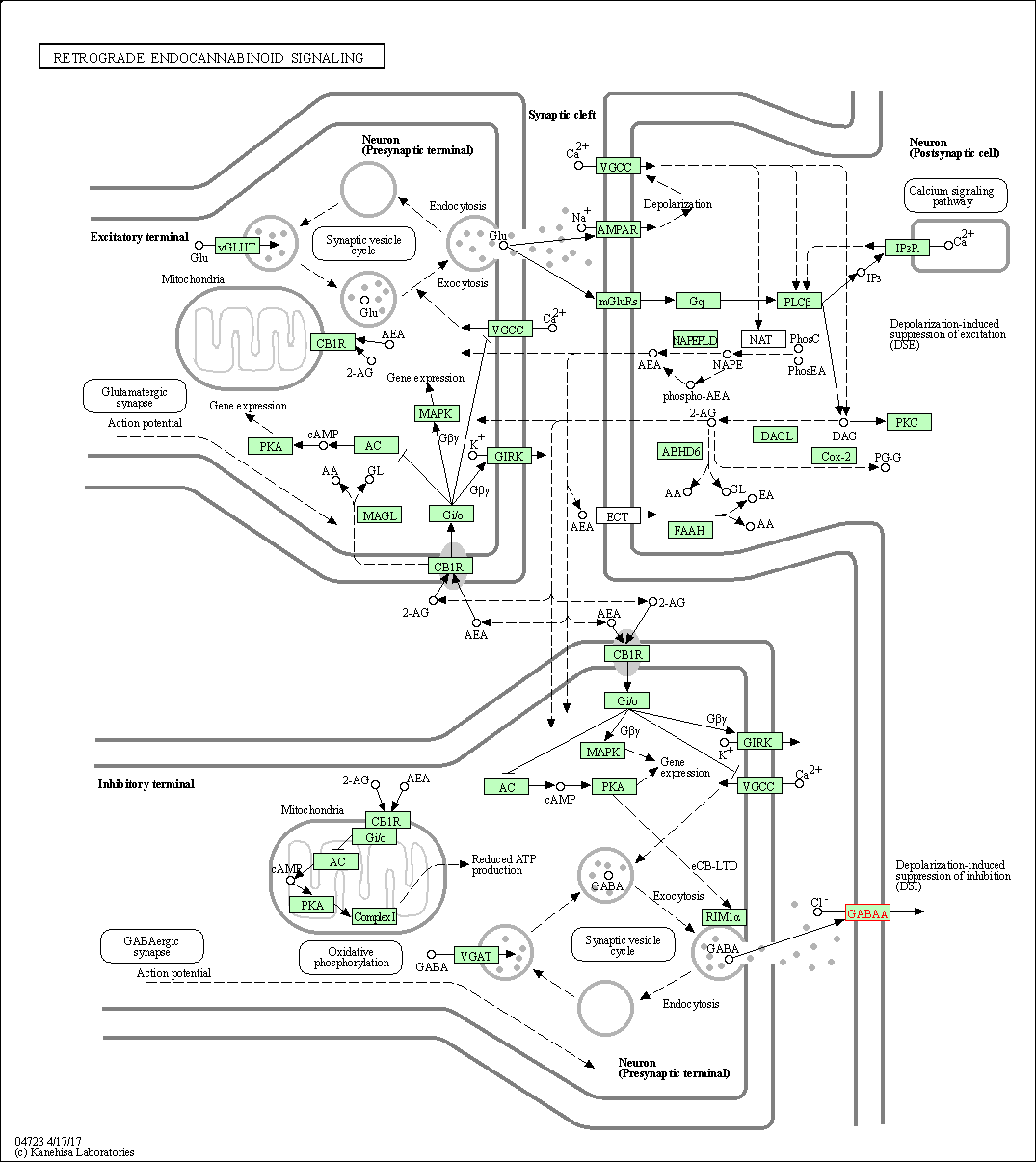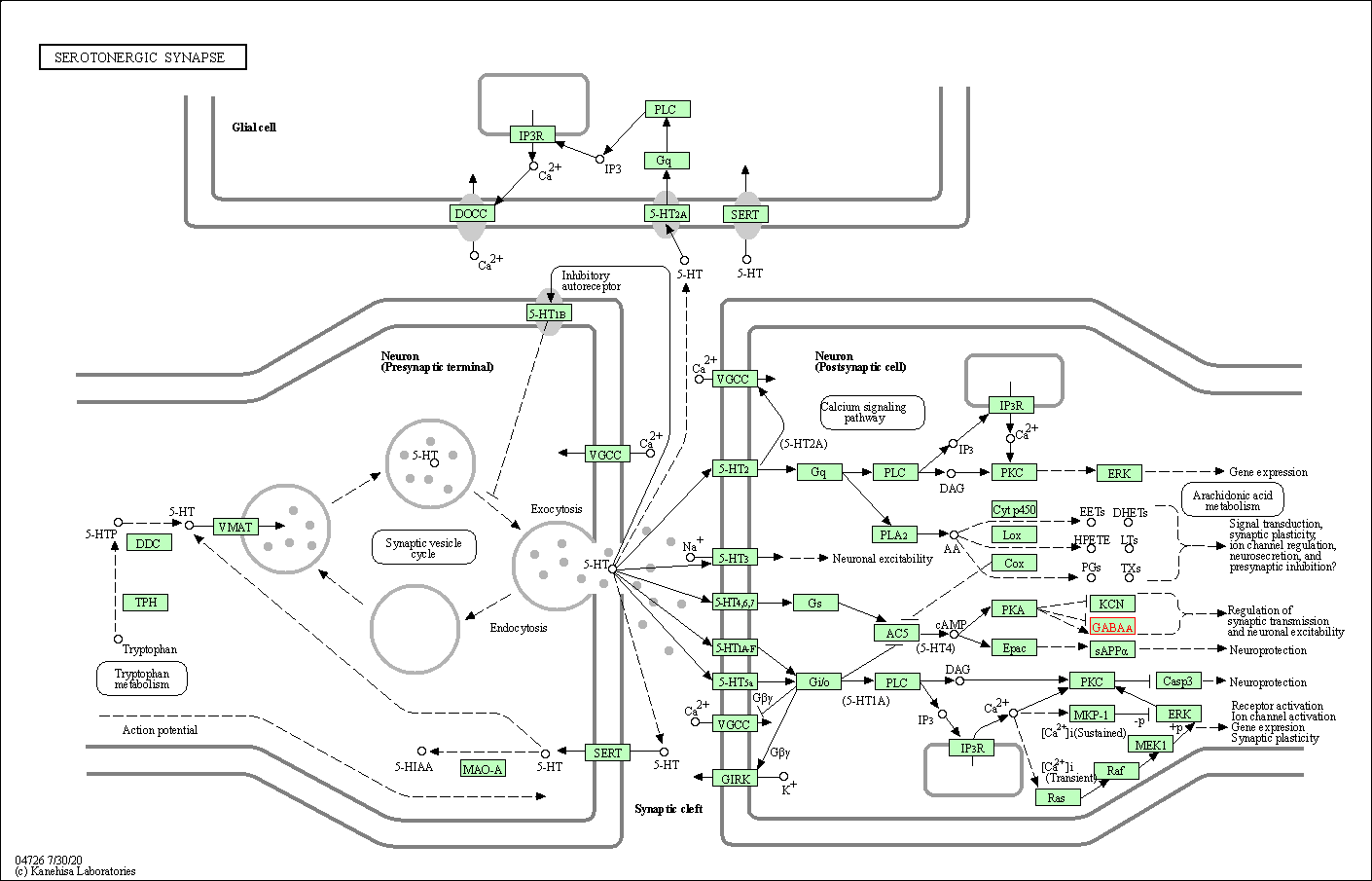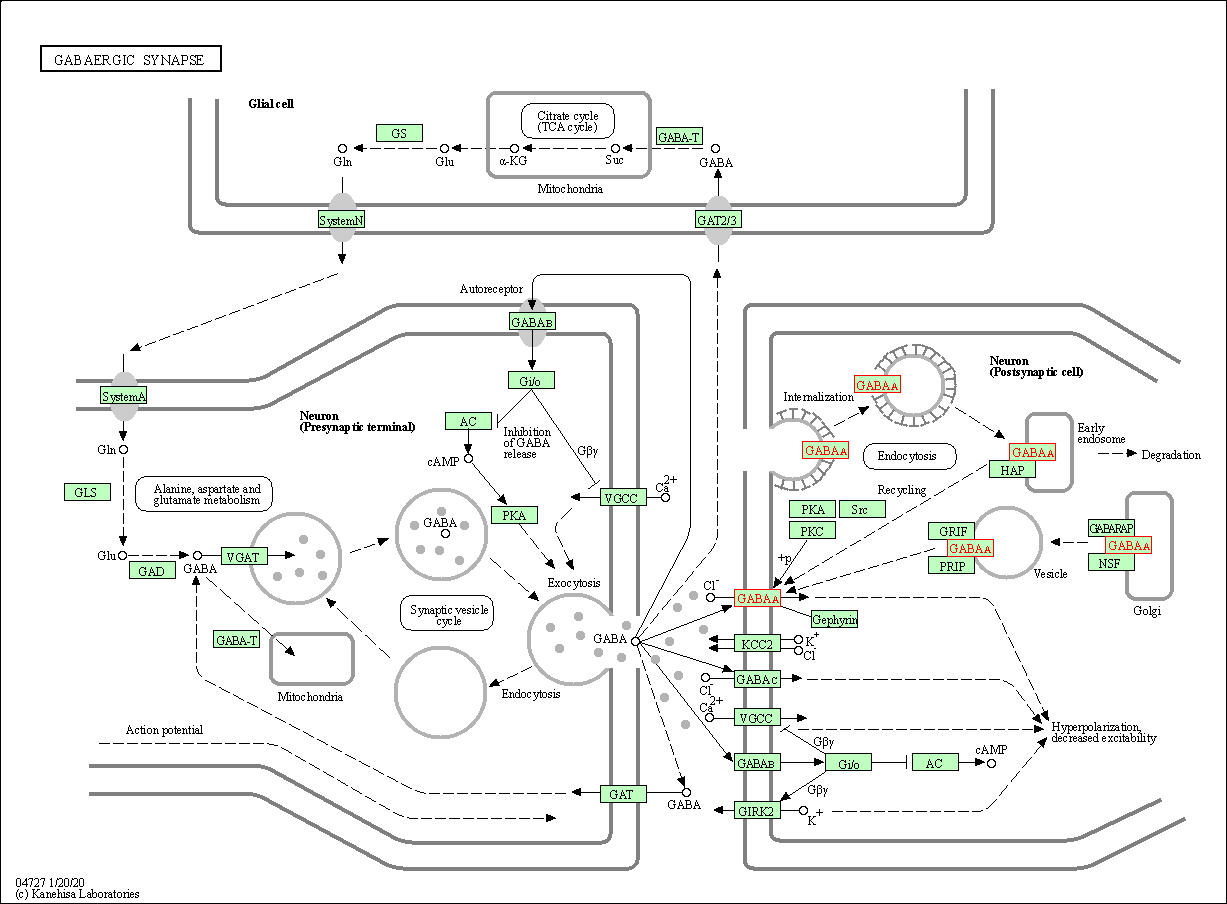Target Information
| Target General Information | Top | |||||
|---|---|---|---|---|---|---|
| Target ID |
T80387
(Former ID: TTDS00410)
|
|||||
| Target Name |
GABA(A) receptor beta-2 (GABRB2)
|
|||||
| Synonyms |
GABRB2; GABA(A) receptor subunit beta-2
Click to Show/Hide
|
|||||
| Gene Name |
GABRB2
|
|||||
| Target Type |
Successful target
|
[1] | ||||
| Disease | [+] 4 Target-related Diseases | + | ||||
| 1 | Depression [ICD-11: 6A70-6A7Z] | |||||
| 2 | Insomnia [ICD-11: 7A00-7A0Z] | |||||
| 3 | Mental/behavioural/neurodevelopmental disorder [ICD-11: 6E20-6E8Z] | |||||
| 4 | Tonus and reflex abnormality [ICD-11: MB47] | |||||
| Function |
Component of the heteropentameric receptor for GABA, the major inhibitory neurotransmitter in the vertebrate brain. Functions also as histamine receptor and mediates cellular responses to histamine. Functions as receptor for diazepines and various anesthetics, such as pentobarbital; these are bound at a separate allosteric effector binding site. Functions as ligand- gated chloride channel.
Click to Show/Hide
|
|||||
| BioChemical Class |
Neurotransmitter receptor
|
|||||
| UniProt ID | ||||||
| Sequence |
MWRVRKRGYFGIWSFPLIIAAVCAQSVNDPSNMSLVKETVDRLLKGYDIRLRPDFGGPPV
AVGMNIDIASIDMVSEVNMDYTLTMYFQQAWRDKRLSYNVIPLNLTLDNRVADQLWVPDT YFLNDKKSFVHGVTVKNRMIRLHPDGTVLYGLRITTTAACMMDLRRYPLDEQNCTLEIES YGYTTDDIEFYWRGDDNAVTGVTKIELPQFSIVDYKLITKKVVFSTGSYPRLSLSFKLKR NIGYFILQTYMPSILITILSWVSFWINYDASAARVALGITTVLTMTTINTHLRETLPKIP YVKAIDMYLMGCFVFVFMALLEYALVNYIFFGRGPQRQKKAAEKAASANNEKMRLDVNKI FYKDIKQNGTQYRSLWDPTGNLSPTRRTTNYDFSLYTMDPHENILLSTLEIKNEMATSEA VMGLGDPRSTMLAYDASSIQYRKAGLPRHSFGRNALERHVAQKKSRLRRRASQLKITIPD LTDVNAIDRWSRIFFPVVFSFFNIVYWLYYVN Click to Show/Hide
|
|||||
| 3D Structure | Click to Show 3D Structure of This Target | AlphaFold | ||||
| Drugs and Modes of Action | Top | |||||
|---|---|---|---|---|---|---|
| Approved Drug(s) | [+] 3 Approved Drugs | + | ||||
| 1 | Allopregnanolone | Drug Info | Approved | Postpartum depression | [2], [3] | |
| 2 | Ethchlorvynol | Drug Info | Approved | Insomnia | [4], [5] | |
| 3 | THIOCOLCHICOSIDE | Drug Info | Approved | Muscle spasm | [6] | |
| Clinical Trial Drug(s) | [+] 2 Clinical Trial Drugs | + | ||||
| 1 | ZK-93423 | Drug Info | Phase 3 | Epileptic seizures | [7], [8] | |
| 2 | GSK683699 | Drug Info | Phase 2 | Inflammatory bowel disease | [9] | |
| Discontinued Drug(s) | [+] 2 Discontinued Drugs | + | ||||
| 1 | ELTANOLONE | Drug Info | Discontinued in Phase 3 | Premenstrual syndrome | [10] | |
| 2 | U-78875 | Drug Info | Discontinued in Phase 1 | Anxiety disorder | [11] | |
| Mode of Action | [+] 3 Modes of Action | + | ||||
| Inhibitor | [+] 81 Inhibitor drugs | + | ||||
| 1 | Allopregnanolone | Drug Info | [12] | |||
| 2 | THIOCOLCHICOSIDE | Drug Info | [13] | |||
| 3 | ZK-93423 | Drug Info | [14] | |||
| 4 | GSK683699 | Drug Info | [13] | |||
| 5 | ELTANOLONE | Drug Info | [12] | |||
| 6 | U-78875 | Drug Info | [15] | |||
| 7 | (2E,4S)-4-ammoniopent-2-enoate | Drug Info | [16] | |||
| 8 | (4R)-4-ammoniopentanoate | Drug Info | [16] | |||
| 9 | (4S)-4-ammoniopentanoate | Drug Info | [16] | |||
| 10 | (9-Benzyl-9H-purin-6-yl)-cyclopropyl-amine | Drug Info | [17] | |||
| 11 | 1,1-Dimethyl-5-oxa-spiro[2.4]heptan-4-one | Drug Info | [18] | |||
| 12 | 1-(4-chlorophenyl)-4-phenyl-1H-imidazole | Drug Info | [19] | |||
| 13 | 1-Methyl-5-oxa-spiro[2.4]heptan-4-one | Drug Info | [18] | |||
| 14 | 2-(4-chlorophenyl)-5-phenyl-4-isoxazolin-3-one | Drug Info | [19] | |||
| 15 | 2-(9-Benzyl-9H-purin-6-ylamino)-ethanol | Drug Info | [17] | |||
| 16 | 2-Isoxazol-5-yl-3H-imidazo[4,5-c]quinoline | Drug Info | [20] | |||
| 17 | 2-Thiophen-2-yl-3H-imidazo[4,5-c]quinoline | Drug Info | [20] | |||
| 18 | 3,3-Diethyl-dihydro-furan-2-one | Drug Info | [18] | |||
| 19 | 3,3-Diisopropyl-dihydro-furan-2-one | Drug Info | [18] | |||
| 20 | 3-amino-3-demethoxythiocolchicine | Drug Info | [13] | |||
| 21 | 3-butoxycarbonyl-4-quinolone | Drug Info | [21] | |||
| 22 | 3-butoxycarbonyl-6-ethyl-4-quinolone | Drug Info | [21] | |||
| 23 | 3-carboxy-6-ethyl-4-quinolone | Drug Info | [21] | |||
| 24 | 3-cyclopentoxycarbonyl-6-ethyl-4-quinolone | Drug Info | [21] | |||
| 25 | 3-demethoxy-3-D-lyxopyranosylaminothiocolchicine | Drug Info | [13] | |||
| 26 | 3-demethoxy-3-D-mannopyranosylaminothiocolchicine | Drug Info | [13] | |||
| 27 | 3-demethoxy-3-D-xylopyranosylaminothiocolchicine | Drug Info | [13] | |||
| 28 | 3-demethoxy-3-L-fucopyranosylaminothiocolchicine | Drug Info | [13] | |||
| 29 | 3-demethoxy-3D-glucopyranosylaminothiocolchicine | Drug Info | [13] | |||
| 30 | 3-ethoxycarbonyl-4-quinolone | Drug Info | [21] | |||
| 31 | 3-ethoxycarbonyl-6-ethyl-2-methyl-4-quinolone | Drug Info | [21] | |||
| 32 | 3-ethoxycarbonyl-6-propyl-4-quinolone | Drug Info | [21] | |||
| 33 | 3-Ethyl-3-isopropyl-dihydro-furan-2-one | Drug Info | [18] | |||
| 34 | 3-Ethyl-3-methyl-dihydro-furan-2-one | Drug Info | [18] | |||
| 35 | 3-Isopropyl-3-methyl-dihydro-furan-2-one | Drug Info | [18] | |||
| 36 | 3-Isothiocyanato-9H-beta-carboline | Drug Info | [22] | |||
| 37 | 3-Methyl-9H-beta-carboline | Drug Info | [23] | |||
| 38 | 3-tert-Butyl-3-ethyl-dihydro-furan-2-one | Drug Info | [18] | |||
| 39 | 4-(2-aminoethyl)-1,2,5-oxadiazol-3-ol | Drug Info | [24] | |||
| 40 | 4-(4-chlorophenyl)-1-pyrid-2-yl-pyrazole | Drug Info | [19] | |||
| 41 | 4-(biphenyl-3-yl)-5-(piperidin-4-yl)isoxazol-3-ol | Drug Info | [25] | |||
| 42 | 4-Benzyl-5-piperidin-4-yl-isoxazol-3-ol | Drug Info | [26] | |||
| 43 | 4-Naphthalen-1-yl-5-piperidin-4-yl-isoxazol-3-ol | Drug Info | [26] | |||
| 44 | 4-Naphthalen-2-yl-5-piperidin-4-yl-isoxazol-3-ol | Drug Info | [26] | |||
| 45 | 5-(piperidin-4-yl)isoxazol-3-ol | Drug Info | [26] | |||
| 46 | 5-[(1R)-1-ammonioethyl]isoxazol-3-olate | Drug Info | [16] | |||
| 47 | 5-[(1S)-1-ammonioethyl]isoxazol-3-olate | Drug Info | [16] | |||
| 48 | 6,9-Dimethyl-2-oxa-spiro[4.4]nonan-1-one | Drug Info | [18] | |||
| 49 | 6-benzyl-3-ethoxycarbonyl-4-quinolone | Drug Info | [21] | |||
| 50 | 6-benzyl-3-propoxycarbonyl-4-quinolone | Drug Info | [21] | |||
| 51 | 6-benzyl-3-propylaminocarbonyl-4-quinolone | Drug Info | [21] | |||
| 52 | 6-bromo-3-ethoxycarbonyl-2-methyl-4-quinolone | Drug Info | [21] | |||
| 53 | 6-bromo-3-ethoxycarbonyl-4-quinolone | Drug Info | [21] | |||
| 54 | 6-ethyl-3-(2-ethylbutoxycarbonyl)-4-quinolone | Drug Info | [21] | |||
| 55 | 6-ethyl-3-(2-methylbutoxycarbonyl)-4-quinolone | Drug Info | [21] | |||
| 56 | 6-ethyl-3-(3-methylbutoxycarbonyl)-4-quinolone | Drug Info | [21] | |||
| 57 | 6-ethyl-3-(3-pentoxycarbonyl)-4-quinolone | Drug Info | [21] | |||
| 58 | 6-ethyl-3-i-propoxycarbonyl-4-quinolone | Drug Info | [21] | |||
| 59 | 6-ethyl-3-pentoxycarbonyl-4-quinolone | Drug Info | [21] | |||
| 60 | 6-ethyl-3-propoxycarbonyl-4-quinolone | Drug Info | [21] | |||
| 61 | 6-ethyl-3-propylaminocarbonyl-4-quinolone | Drug Info | [21] | |||
| 62 | 6-Methyl-2-oxa-spiro[4.4]nonan-1-one | Drug Info | [18] | |||
| 63 | AMENTOFLAVONE | Drug Info | [27] | |||
| 64 | BETA-CCM | Drug Info | [23] | |||
| 65 | CGS-13767 | Drug Info | [28] | |||
| 66 | CI-218872 | Drug Info | [23] | |||
| 67 | GNF-PF-4421 | Drug Info | [21] | |||
| 68 | N-(p-methylbenzyl)-5-nitroindol-3-ylglyoxylamide | Drug Info | [29] | |||
| 69 | N-Benzyl-2-(1H-indol-3-yl)-2-oxo-acetamide | Drug Info | [29] | |||
| 70 | N-benzyl-2-(5-nitro-1H-indol-3-yl)-2-oxoacetamide | Drug Info | [29] | |||
| 71 | N-butyl-2-(1H-indol-3-yl)-2-oxoacetamide | Drug Info | [29] | |||
| 72 | N-butyl-2-(5-nitro-1H-indol-3-yl)-2-oxoacetamide | Drug Info | [29] | |||
| 73 | N-Indan-1-yl-2-(1H-indol-3-yl)-2-oxo-acetamide | Drug Info | [30] | |||
| 74 | Ridine-5-carboxylic acid ethyl ester | Drug Info | [31] | |||
| 75 | RO-145974 | Drug Info | [32] | |||
| 76 | RO-145975 | Drug Info | [32] | |||
| 77 | RO-147437 | Drug Info | [32] | |||
| 78 | Ro-15-3505 | Drug Info | [32] | |||
| 79 | U-89267 | Drug Info | [34] | |||
| 80 | [3H]CGS8216 | Drug Info | [35] | |||
| 81 | [3H]Ro154513 | Drug Info | [32] | |||
| Antagonist | [+] 1 Antagonist drugs | + | ||||
| 1 | Ethchlorvynol | Drug Info | [1] | |||
| Blocker (channel blocker) | [+] 1 Blocker (channel blocker) drugs | + | ||||
| 1 | TBPS | Drug Info | [33] | |||
| Cell-based Target Expression Variations | Top | |||||
|---|---|---|---|---|---|---|
| Cell-based Target Expression Variations | ||||||
| Drug Binding Sites of Target | Top | |||||
|---|---|---|---|---|---|---|
| Ligand Name: Propofol | Ligand Info | |||||
| Structure Description | Human GABAA receptor alpha1-beta2-gamma2 subtype in complex with GABA plus propofol | PDB:6X3T | ||||
| Method | Electron microscopy | Resolution | 2.55 Å | Mutation | No | [36] |
| PDB Sequence |
SNMSLVKETV
16 DRLLKGYDIR26 LRPDFGGPPV36 AVGMNIDIAS46 IDMVSEVNMD56 YTLTMYFQQA 66 WRDKRLSYNV76 IPLNLTLDNR86 VADQLWVPDT96 YFLNDKKSFV106 HGVTVKNRMI 116 RLHPDGTVLY126 GLRITTTAAC136 MMDLRRYPLD146 EQNCTLEIES156 YGYTTDDIEF 166 YWRGDDNAVT176 GVTKIELPQF186 SIVDYKLITK196 KVVFSTGSYP206 RLSLSFKLKR 216 NIGYFILQTY226 MPSILITILS236 WVSFWINYDA246 SAARVALGIT256 TVLTMTTINT 266 HLRETLPKIP276 YVKAIDMYLM286 GCFVFVFMAL296 LEYALVNYIF306 FSQPARAAAI 316 DRWSRIFFPV326 VFSFFNIVYW336 LYYV
|
|||||
|
|
||||||
| Ligand Name: Zolpidem | Ligand Info | |||||
| Structure Description | Human GABAA receptor alpha1-beta2-gamma2 subtype in complex with GABA plus Zolpidem | PDB:8DD2 | ||||
| Method | Electron microscopy | Resolution | 2.90 Å | Mutation | No | [37] |
| PDB Sequence |
SNMSLVKETV
16 DRLLKGYDIR26 LRPDFGGPPV36 AVGMNIDIAS46 IDMVSEVNMD56 YTLTMYFQQA 66 WRDKRLSYNV76 IPLNLTLDNR86 VADQLWVPDT96 YFLNDKKSFV106 HGVTVKNRMI 116 RLHPDGTVLY126 GLRITTTAAC136 MMDLRRYPLD146 EQNCTLEIES156 YGYTTDDIEF 166 YWRGDDNAVT176 GVTKIELPQF186 SIVDYKLITK196 KVVFSTGSYP206 RLSLSFKLKR 216 NIGYFILQTY226 MPSILITILS236 WVSFWINYDA246 SAARVALGIT256 TVLTMTTINT 266 HLRETLPKIP276 YVKAIDMYLM286 GCFVFVFMAL296 LEYALVNYIF306 FSQPARAAAI 316 DRWSRIFFPV326 VFSFFNIVYW336 LYYV
|
|||||
|
|
||||||
| Click to View More Binding Site Information of This Target with Different Ligands | ||||||
| Different Human System Profiles of Target | Top |
|---|---|
|
Human Similarity Proteins
of target is determined by comparing the sequence similarity of all human proteins with the target based on BLAST. The similarity proteins for a target are defined as the proteins with E-value < 0.005 and outside the protein families of the target.
A target that has fewer human similarity proteins outside its family is commonly regarded to possess a greater capacity to avoid undesired interactions and thus increase the possibility of finding successful drugs
(Brief Bioinform, 21: 649-662, 2020).
Human Tissue Distribution
of target is determined from a proteomics study that quantified more than 12,000 genes across 32 normal human tissues. Tissue Specificity (TS) score was used to define the enrichment of target across tissues.
The distribution of targets among different tissues or organs need to be taken into consideration when assessing the target druggability, as it is generally accepted that the wider the target distribution, the greater the concern over potential adverse effects
(Nat Rev Drug Discov, 20: 64-81, 2021).
Human Pathway Affiliation
of target is determined by the life-essential pathways provided on KEGG database. The target-affiliated pathways were defined based on the following two criteria (a) the pathways of the studied target should be life-essential for both healthy individuals and patients, and (b) the studied target should occupy an upstream position in the pathways and therefore had the ability to regulate biological function.
Targets involved in a fewer pathways have greater likelihood to be successfully developed, while those associated with more human pathways increase the chance of undesirable interferences with other human processes
(Pharmacol Rev, 58: 259-279, 2006).
Biological Network Descriptors
of target is determined based on a human protein-protein interactions (PPI) network consisting of 9,309 proteins and 52,713 PPIs, which were with a high confidence score of ≥ 0.95 collected from STRING database.
The network properties of targets based on protein-protein interactions (PPIs) have been widely adopted for the assessment of target’s druggability. Proteins with high node degree tend to have a high impact on network function through multiple interactions, while proteins with high betweenness centrality are regarded to be central for communication in interaction networks and regulate the flow of signaling information
(Front Pharmacol, 9, 1245, 2018;
Curr Opin Struct Biol. 44:134-142, 2017).
Human Similarity Proteins
Human Tissue Distribution
Human Pathway Affiliation
Biological Network Descriptors
|
|
|
There is no similarity protein (E value < 0.005) for this target
|
|
Note:
If a protein has TS (tissue specficity) scores at least in one tissue >= 2.5, this protein is called tissue-enriched (including tissue-enriched-but-not-specific and tissue-specific). In the plots, the vertical lines are at thresholds 2.5 and 4.
|
| KEGG Pathway | Pathway ID | Affiliated Target | Pathway Map |
|---|---|---|---|
| Neuroactive ligand-receptor interaction | hsa04080 | Affiliated Target |

|
| Class: Environmental Information Processing => Signaling molecules and interaction | Pathway Hierarchy | ||
| Retrograde endocannabinoid signaling | hsa04723 | Affiliated Target |

|
| Class: Organismal Systems => Nervous system | Pathway Hierarchy | ||
| Serotonergic synapse | hsa04726 | Affiliated Target |

|
| Class: Organismal Systems => Nervous system | Pathway Hierarchy | ||
| GABAergic synapse | hsa04727 | Affiliated Target |

|
| Class: Organismal Systems => Nervous system | Pathway Hierarchy | ||
| Degree | 1 | Degree centrality | 1.07E-04 | Betweenness centrality | 0.00E+00 |
|---|---|---|---|---|---|
| Closeness centrality | 1.45E-01 | Radiality | 1.18E+01 | Clustering coefficient | 0.00E+00 |
| Neighborhood connectivity | 5.00E+00 | Topological coefficient | 1.00E+00 | Eccentricity | 14 |
| Download | Click to Download the Full PPI Network of This Target | ||||
| Drug Property Profile of Target | Top | |
|---|---|---|
| (1) Molecular Weight (mw) based Drug Clustering | (2) Octanol/Water Partition Coefficient (xlogp) based Drug Clustering | |
|
|
||
| (3) Hydrogen Bond Donor Count (hbonddonor) based Drug Clustering | (4) Hydrogen Bond Acceptor Count (hbondacc) based Drug Clustering | |
|
|
||
| (5) Rotatable Bond Count (rotbonds) based Drug Clustering | (6) Topological Polar Surface Area (polararea) based Drug Clustering | |
|
|
||
| "RO5" indicates the cutoff set by lipinski's rule of five; "D123AB" colored in GREEN denotes the no violation of any cutoff in lipinski's rule of five; "D123AB" colored in PURPLE refers to the violation of only one cutoff in lipinski's rule of five; "D123AB" colored in BLACK represents the violation of more than one cutoffs in lipinski's rule of five | ||
| Co-Targets | Top | |||||
|---|---|---|---|---|---|---|
| Co-Targets | ||||||
| Target Profiles in Patients | Top | |||||
|---|---|---|---|---|---|---|
| Target Expression Profile (TEP) | ||||||
| Target Affiliated Biological Pathways | Top | |||||
|---|---|---|---|---|---|---|
| KEGG Pathway | [+] 6 KEGG Pathways | + | ||||
| 1 | Neuroactive ligand-receptor interaction | |||||
| 2 | Retrograde endocannabinoid signaling | |||||
| 3 | Serotonergic synapse | |||||
| 4 | GABAergic synapse | |||||
| 5 | Morphine addiction | |||||
| 6 | Nicotine addiction | |||||
| Reactome | [+] 2 Reactome Pathways | + | ||||
| 1 | Ligand-gated ion channel transport | |||||
| 2 | GABA A receptor activation | |||||
| WikiPathways | [+] 2 WikiPathways | + | ||||
| 1 | Neurotransmitter Receptor Binding And Downstream Transmission In The Postsynaptic Cell | |||||
| 2 | Iron uptake and transport | |||||
| Target-Related Models and Studies | Top | |||||
|---|---|---|---|---|---|---|
| Target Validation | ||||||
| References | Top | |||||
|---|---|---|---|---|---|---|
| REF 1 | DrugBank: a knowledgebase for drugs, drug actions and drug targets. Nucleic Acids Res. 2008 Jan;36(Database issue):D901-6. | |||||
| REF 2 | Antibodies and venom peptides: new modalities for ion channels. Nat Rev Drug Discov. 2019 May;18(5):339-357. | |||||
| REF 3 | Clinical pipeline report, company report or official report of the Pharmaceutical Research and Manufacturers of America (PhRMA) | |||||
| REF 4 | URL: http://www.guidetopharmacology.org Nucleic Acids Res. 2015 Oct 12. pii: gkv1037. The IUPHAR/BPS Guide to PHARMACOLOGY in 2016: towards curated quantitative interactions between 1300 protein targets and 6000 ligands. (Ligand id: 7180). | |||||
| REF 5 | FDA Approved Drug Products from FDA Official Website. 2009. Application Number: (ANDA) 084463. | |||||
| REF 6 | Drugs@FDA. U.S. Food and Drug Administration. U.S. Department of Health & Human Services. 2015 | |||||
| REF 7 | URL: http://www.guidetopharmacology.org Nucleic Acids Res. 2015 Oct 12. pii: gkv1037. The IUPHAR/BPS Guide to PHARMACOLOGY in 2016: towards curated quantitative interactions between 1300 protein targets and 6000 ligands. (Ligand id: 4346). | |||||
| REF 8 | Abecarnil enhances GABA-induced currents in acutely isolated cerebellar Purkinje cells. Neuropharmacology. 1995 Feb;34(2):157-63. | |||||
| REF 9 | Emerging drugs to treat Crohn's disease. Expert Opin Emerg Drugs. 2007 Mar;12(1):49-59. | |||||
| REF 10 | Trusted, scientifically sound profiles of drug programs, clinical trials, safety reports, and company deals, written by scientists. Springer. 2015. Adis Insight (drug id 800005875) | |||||
| REF 11 | Trusted, scientifically sound profiles of drug programs, clinical trials, safety reports, and company deals, written by scientists. Springer. 2015. Adis Insight (drug id 800001194) | |||||
| REF 12 | Neurosteroid analogues. 10. The effect of methyl group substitution at the C-6 and C-7 positions on the GABA modulatory and anesthetic actions of (... J Med Chem. 2005 Apr 21;48(8):3051-9. | |||||
| REF 13 | 3-demethoxy-3-glycosylaminothiocolchicines: Synthesis of a new class of putative muscle relaxant compounds. J Med Chem. 2006 Sep 7;49(18):5571-7. | |||||
| REF 14 | Structural requirements for agonist actions at the benzodiazepine receptor: studies with analogues of 6-(benzyloxy)-4-(methoxymethyl)-beta-carbolin... J Med Chem. 1990 Mar;33(3):1062-9. | |||||
| REF 15 | High-affinity alpha-aminobutyric acid A/benzodiazepine ligands: synthesis and structure-activity relationship studies of a new series of tetracycli... J Med Chem. 1996 Nov 8;39(23):4654-66. | |||||
| REF 16 | gamma-Aminobutyric acid agonists, antagonists, and uptake inhibitors. Design and therapeutic aspects. J Med Chem. 1981 Dec;24(12):1377-83. | |||||
| REF 17 | Benzodiazepine receptor binding activity of 6,9-disubstituted purines. J Med Chem. 1989 May;32(5):1020-4. | |||||
| REF 18 | Alpha-spirocyclopentyl- and alpha-spirocyclopropyl-gamma-butyrolactones: conformationally constrained derivatives of anticonvulsant and convulsant ... J Med Chem. 1994 Jan 21;37(2):275-86. | |||||
| REF 19 | Synthesis, pharmacology, and structure-activity relationships of novel imidazolones and pyrrolones as modulators of GABAA receptors. J Med Chem. 2006 Mar 23;49(6):1855-66. | |||||
| REF 20 | Synthesis and structure--activity relationships of fused imidazopyridines: a new series of benzodiazepine receptor ligands. J Med Chem. 1996 Jul 5;39(14):2844-51. | |||||
| REF 21 | 4-quinolone derivatives: high-affinity ligands at the benzodiazepine site of brain GABA A receptors. synthesis, pharmacology, and pharmacophore mod... J Med Chem. 2006 Apr 20;49(8):2526-33. | |||||
| REF 22 | Synthetic and computer-assisted analyses of the pharmacophore for the benzodiazepine receptor inverse agonist site. J Med Chem. 1990 Sep;33(9):2343-57. | |||||
| REF 23 | Four amino acid exchanges convert a diazepam-insensitive, inverse agonist-preferring GABAA receptor into a diazepam-preferring GABAA receptor. J Med Chem. 1994 Dec 23;37(26):4576-80. | |||||
| REF 24 | Hydroxy-1,2,5-oxadiazolyl moiety as bioisoster of the carboxy function. Synthesis, ionization constants, and pharmacological characterization of ga... J Med Chem. 2006 Jul 13;49(14):4442-6. | |||||
| REF 25 | Novel 4-(piperidin-4-yl)-1-hydroxypyrazoles as gamma-aminobutyric acid(A) receptor ligands: synthesis, pharmacology, and structure-activity relatio... J Med Chem. 2010 Apr 22;53(8):3417-21. | |||||
| REF 26 | Potent 4-aryl- or 4-arylalkyl-substituted 3-isoxazolol GABA(A) antagonists: synthesis, pharmacology, and molecular modeling. J Med Chem. 2005 Jan 27;48(2):427-39. | |||||
| REF 27 | Semisynthetic preparation of amentoflavone: A negative modulator at GABA(A) receptors. Bioorg Med Chem Lett. 2003 Jul 21;13(14):2281-4. | |||||
| REF 28 | Synthesis and benzodiazepine binding activity of a series of novel [1,2,4]triazolo[1,5-c]quinazolin-5(6H)-ones. J Med Chem. 1991 Jan;34(1):281-90. | |||||
| REF 29 | Novel N-substituted indol-3-ylglyoxylamides probing the LDi and L1/L2 lipophilic regions of the benzodiazepine receptor site in search for subtype-... J Med Chem. 2007 Apr 5;50(7):1627-34. | |||||
| REF 30 | Novel N-(arylalkyl)indol-3-ylglyoxylylamides targeted as ligands of the benzodiazepine receptor: synthesis, biological evaluation, and molecular mo... J Med Chem. 2001 Jul 5;44(14):2286-97. | |||||
| REF 31 | Synthesis and structure-activity relationships of a series of anxioselective pyrazolopyridine ester and amide anxiolytic agents. J Med Chem. 1989 Dec;32(12):2561-73. | |||||
| REF 32 | Synthesis and evaluation of imidazo[1,5-a][1,4]benzodiazepine esters with high affinities and selectivities at "diazepam-insensitive" benzodiazepin... J Med Chem. 1993 Apr 16;36(8):1001-6. | |||||
| REF 33 | URL: http://www.guidetopharmacology.org Nucleic Acids Res. 2015 Oct 12. pii: gkv1037. The IUPHAR/BPS Guide to PHARMACOLOGY in 2016: towards curated quantitative interactions between 1300 protein targets and 6000 ligands. (Target id: 411). | |||||
| REF 34 | Antagonist, partial agonist, and full agonist imidazo[1,5-a]quinoxaline amides and carbamates acting through the GABAA/benzodiazepine receptor. J Med Chem. 1994 Mar 18;37(6):758-68. | |||||
| REF 35 | Substituted 3-(2-benzoxazyl)-benzimidazol-2-(1H)-ones: a new class of GABA(A) brain receptor ligands. Bioorg Med Chem Lett. 2000 Dec 18;10(24):2723-6. | |||||
| REF 36 | Shared structural mechanisms of general anaesthetics and benzodiazepines. Nature. 2020 Sep;585(7824):303-308. | |||||
| REF 37 | Structural and dynamic mechanisms of GABA(A) receptor modulators with opposing activities. Nat Commun. 2022 Aug 6;13(1):4582. | |||||
If You Find Any Error in Data or Bug in Web Service, Please Kindly Report It to Dr. Zhou and Dr. Zhang.

